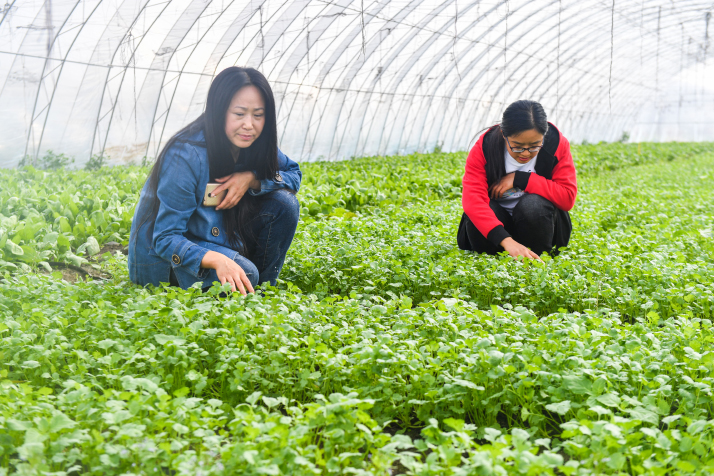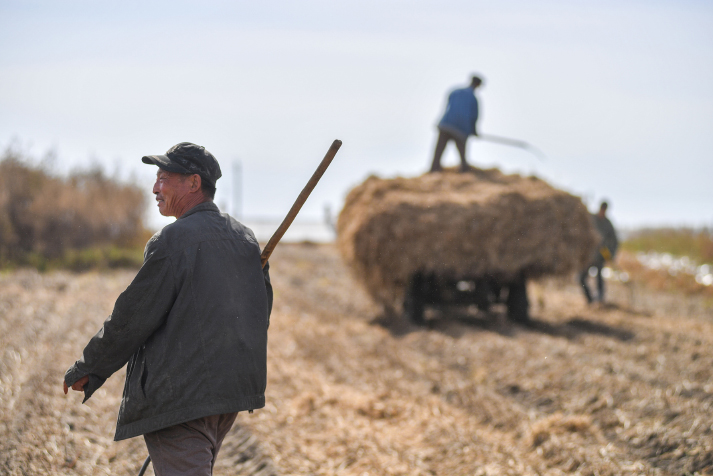|
||||||
|
||||||
| Home Nation World Business Opinion Lifestyle China Focus ChinAfrica Multimedia Columnists Documents Special Reports |
|
||||||
|
||||||
| Home Nation World Business Opinion Lifestyle China Focus ChinAfrica Multimedia Columnists Documents Special Reports |
| Nation |
| Golden Green Farms |
| The vitalization of rural areas has accelerated as more entrepreneurs and young people get involved |
| By Yuan Yuan | NO. 44 NOVEMBER 1, 2018 |
A field study on greenhouse agriculture is carried out in Changsheng Village of Zhaodong, Suihua City in northeast China's Heilongjiang Province, on September 29 (WEI YAO)
With machines roaring, workers at a corn-processing factory in Xiangyang Village of Zhaodong, Suihua City in northeast China's Heilongjiang Province, were busy peeling, washing, boiling and then packaging corn. Boxes containing corn piled up around the factory. Wang Zhongbao, the owner of the plant, was busy answering calls from people wanting to place orders. "Our production volume can't meet the growing demand," Wang said. "I have to turn most of them away. We are planning to expand the plant to a much larger scale." Working as a barefoot doctor in the village for over a decade, Wang decided to start his own poultry-raising business in 2005. He started with 2,000 chickens and spent a lot of time learning from skilled villagers and veterinarians how to avoid diseases and raise healthier chickens that would produce more eggs. Within a few years, he expanded to 5,000 chickens and then to over 10,000, involving more villagers in the process. In order to pool more labor and resources together, Wang initiated a large-scale poultry-raising cooperative in 2008, setting up standardized technical support, supply chains and prices. More than 100 households joined, increasing the number of chickens to 800,000 and adding 100,000 geese. In the first year, each household in the cooperative earned over 30,000 yuan ($4,500) on average. By 2015, the total number of households involved had increased to 1,660, including some from other towns across the province. When it was found that corn had such a large market, Wang expanded his business to include corn and other grains, setting up Wang Lao Bao Food Co. Ltd. in 2014. Today, the total assets of the company have surpassed 50 million yuan ($7.35 million) with net profits hitting 8 million yuan ($1.17 million) a year. More than 200 villagers are employed in the corn-processing factory during the busy season. "Now we have 15,000 mu (1,000 hectares) of corn fields and we expect to expand," Wang said. With no additives or sugars involved in the processing, the corn is 100 percent organic and green, making it very popular with consumers even though it is not cheap. The market price for a regular ear of corn is normally 2 yuan ($0.3), but Wang's corn can sell for up to 9.8 yuan ($1.4), almost five times the average. "The market for green and organic food has been increasing as more consumers become concerned about food safety. This is an opportunity for us to develop modern agriculture," Wang said. "I hope more villagers can explore more in this direction." "We have greatly developed green and organic agriculture in recent years," Yin Cai, Deputy Director of the Zhaodong Bureau of Agriculture, told Beijing Review. "Among the total 3.7 million mu (246,67 hectares) of farmland, more than 1.1 million mu (73,333 hectares) is for green and organic farming." Yin said that corn, the main crop in Zhaodong, is now following a healthier growing pattern. In the past, farmers paid a lot of attention to increasing the output volume by using chemical fertilizers, but this made the product more vulnerable to the market, since buyers had the final say on the price. Now as farmers begin to pay more attention to increasing quality and focus on organic solutions and as more consumers are willing to pay more for organic food, those who produce quality crops are turning out to be the price controllers. In the past, the price for regular millet was about 6 yuan ($0.88) per kg, but now, with more local companies involved in organic crop supply, the price of organic millet can surpass 40 yuan ($5.88).  Pan Shufan and her daughter Xiao Zhijie work in a greenhouse in Changsheng Village of Zhaodong on September 29 (WEI YAO)
Pretty and wealthy
Zhao Hongli, from Changsheng Village in Zhaodong, is an entrepreneurial pioneer. Before returning to the village and being elected secretary of the village Communist Party of China (CPC) branch in 2014, Zhao ran a liquor-brewing company for more than 20 years with more than 100 branch offices across the country. "When I was elected village Party secretary, I was aware of the responsibility this entailed: to change the village into a new one," Zhao said. The new village needed to be clean and pretty, according to Zhao. With government grants, which largely improved its transportation conditions, street lights were erected and flowers were planted along the roads as well. "This has greatly changed the appearance of the village," Cui Shuangxing, a resident, said. "We never had any concrete roads before; the unpaved roads were either dusty or muddy. Now it is more convenient."
Zhang Dapeng, Director of the Soybean Office of Haillun, introduces the Heilongjiang Soybean Trading Center scheduled to open in the city at the end of the year on September 28 (WEI YAO) A compound named Happy Courtyard was built as a caring center for seniors and villagers with disabilities. A performing center for errenzhuan, a typical stage performance from northeast China, was built as both an entertainment center for the villagers and a tourist destination. Not far from the center, a garden with various fruits and vegetables was established with a lane shrouded in grape vines down the middle. In the peak summer season, an average of more than 4,000 tourists visit the village every day. Right beside the garden, some 200 newly built greenhouses are available for rent. "Today, many villages are populated with seniors and children," Zhao said. "I hope Changsheng will attract more young people working in cities to come back home by creating more opportunities for them." Xiao Zhijie, a 29-year-old villager in Changsheng, was lured back by the greenhouses. Xiao used to work in Harbin, capital of Heilongjiang, as an accountant after finishing college. "I always wanted to come back to my village to do something, but I didn't see any opportunities for the young before," Xiao said. "Now things are changing." Xiao's mother, Pan Shufan, rented 28 greenhouses to grow pumpkins this year. As an employee at a local insurance company, Pan is about to switch her work focus to the greenhouses. Xiao and her brother were very passionate about getting involved and started to learn related knowledge and market conditions via the Internet. "To work in the greenhouses is more fun and pleasurable for me," Pan said. "To see the process from seed to fruit is a reward you can't get from doing other jobs. This year, we plan to plant pumpkin and if the market proves to be good, we will expand the scale." "Now I can see my family every day and we work together on something we all love. It makes us happy," Xiao said. Zheng Yan, a 33-year-old villager, rented 10 greenhouses for growing a special type of mushroom. For the past two years, he rented farmland to grow corn and soybeans, but this year, he switched to greenhouses and a new plant. "The mushroom I grow is hard to cultivate in north China because it is vulnerable to cold weather," Zheng said. He specifically went to Dalian, a city in northeast China's Liaoning Province, to learn how to grow the plant. "I employ villagers at harvest time and pay them 100 yuan ($14.7) per day per person," Zheng said. The mushroom grew pretty well this year, and he gets visits from villagers frequently asking questions about investment and profits. Zheng expects to earn about 200,000 yuan ($28,800) this year. Cui Shuangxing works in the greenhouses during the harvest season and earns 3,000 yuan ($441) a month. Cui's husband works in a factory in the village and earns a similar salary. In addition, they have about 40 mu (2.7 hectares) of farmland that can bring in about 20,000 yuan ($2,940) a year. "We are currently very satisfied with our life," Cui said. "Our income is more than enough for us." Zhao's vision for the village, however, is more far-reaching. "To earn more is just the first step," he said. "We are planning to set up a Confucius school in the village to spread China's traditional wisdom and morality. This will be beneficial to all of us." Currently, a motorhome park is about to go under construction and will serve as lodgings for tourists. At the end of the year, a TV drama about the village's development will be shot on location, which will be another boost for tourism in the village.  Villagers work in a soybean field in Dongxing Village, Hailun, on September 28 (WEI YAO)
Black soil and soybeans
Liu Chunsheng, Secretary of the CPC Branch of Dongxing Village of Hailun, Suihua City in Heilongjiang, is also planning something big for the village. Having worked at his current position for the past 13 years, Liu is familiar with everything about the village. "There are 14,252 mu (950 hectares) of farmland in the village with 787 households," Liu said. "In the past, each household dealt only with its own farmland, which, in a way, is a waste of labor and is inefficient." In 2012, Liu initiated a cooperative to gather the farmland for collective farming. To date, all households in the village have joined. The cooperative deals with every step of the process, from sowing the seeds to harvesting. The village cooperates with DJI, a Chinese company that makes unmanned aerial vehicles (UAVs), throughout the process. "We have a training base for young villagers to learn the skills needed to use UAVs," Liu said. "The training is all for free and takes 10-15 days. After grasping the skill, one can earn 20,000 to 30,000 yuan ($4,411) during the summer alone." Each year, every household gets a share of the profits from the crops in addition to the regular rent from their farmland.
A worker processes corn at a factory in Xiangyang Village of Zhaodong on September 29 (WEI YAO) "We are planning to build the village into a big community integrating farmland, industry and living areas," Liu said. "We have already created the draft design for this project." Hailun, known as the capital of the mineral selenium due to its selenium-rich black soil, is ideal for growing soybeans. A trading center in Hailun, which is supposed to go into operation by the end of the year, will be a major trade center of its kind in China. "Since 2016, we have organized several tours that publicize our selenium-rich agricultural products to other areas in China," Guo Changsheng, Director of the Office of Selenium Industry of Hailun, said. "The supplement of selenium is beneficial to health, and it could help to prevent cancer." Since February, the tour team has signed contracts with seven cities with contracted volume surpassing 350 million yuan ($50.4 million) by the end of July. "Our products have been well received by the market and our green and healthy products are expected to be on the table of more families soon," Guo said. (Reporting from Heilongjiang Province) Copyedited by Rebeca Toledo Comments to yuanyuan@bjreview.com |
About Us | Contact Us | Advertise with Us | Subscribe
|
||
| Copyright Beijing Review All rights reserved 京ICP备08005356号 京公网安备110102005860号 |